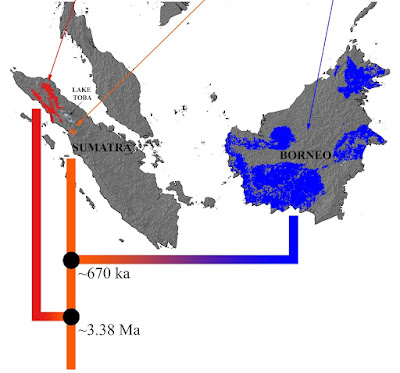 |
| Pongo tapanuliensis Nurcahyo, Meijaard, Nowak, Fredriksson & Groves, 2017 |
 |
| An adult male naps in a tree. There are about 800 Tapanuli orangutans [Pongo tapanuliensis] on Earth, split into three fragmented populations.
Photo: Tim Laman NationalGeographic.com
|
Highlights
• We describe a new species of great apes, the Tapanuli orangutan Pongo tapanuliensis
• Genomic analyses corroborate morphological distinctiveness of P. tapanuliensis
• P. tapanuliensis comprises the oldest evolutionary lineage in the genus Pongo
• With fewer than 800 individuals, P. tapanuliensis is among the most endangered great apes
Summary
Six extant species of non-human great apes are currently recognized: Sumatran and Bornean orangutans, eastern and western gorillas, and chimpanzees and bonobos. However, large gaps remain in our knowledge of fine-scale variation in hominoid morphology, behavior, and genetics, and aspects of great ape taxonomy remain in flux. This is particularly true for orangutans (genus: Pongo), the only Asian great apes and phylogenetically our most distant relatives among extant hominids. Designation of Bornean and Sumatran orangutans, P. pygmaeus (Linnaeus 1760) and P. abelii (Lesson 1827), as distinct species occurred in 2001. Here, we show that an isolated population from Batang Toru, at the southernmost range limit of extant Sumatran orangutans south of Lake Toba, is distinct from other northern Sumatran and Bornean populations. By comparing cranio-mandibular and dental characters of an orangutan killed in a human-animal conflict to those of 33 adult male orangutans of a similar developmental stage, we found consistent differences between the Batang Toru individual and other extant Ponginae. Our analyses of 37 orangutan genomes provided a second line of evidence. Model-based approaches revealed that the deepest split in the evolutionary history of extant orangutans occurred ∼3.38 mya between the Batang Toru population and those to the north of Lake Toba, whereas both currently recognized species separated much later, about 674 kya. Our combined analyses support a new classification of orangutans into three extant species. The new species, Pongo tapanuliensis, encompasses the Batang Toru population, of which fewer than 800 individuals survive.
Results
Despite decades of field studies, our knowledge of variation among orangutans remains limited as many populations occur in isolated and inaccessible habitats, leaving questions regarding their evolutionary history and taxonomic classification largely unresolved. In particular, Sumatran populations south of Lake Toba had long been overlooked, even though a 1939 review of the species’ range mentioned that orangutans had been reported in several forest areas in that region [4]. Based on diverse sources of evidence, we describe a new orangutan species, Pongo tapanuliensis, that encompasses a geographically and genetically isolated population found in the Batang Toru area at the southernmost range limit of extant Sumatran orangutans, south of Lake Toba, Indonesia.
Systematics
Genus Pongo Lacépède, 1799.
Pongo tapanuliensis sp. nov. Nurcahyo, Meijaard, Nowak, Fredriksson & Groves.
Tapanuli Orangutan.
Etymology: The species name refers to three North Sumatran districts (North, Central, and South Tapanuli) to which P. tapanuliensis is endemic.
Description: Craniometrically, the type skull of P. tapanuliensis (Figure 1B) is significantly smaller than any skull of comparable developmental stage of other orangutans; it falls outside of the interquartile ranges of P. abelii and P. pygmaeus for 24 of 39 cranio-mandibular measurements. A principal-component analysis (PCA) of 26 cranio-mandibular measurements commonly used in primate taxonomic classification shows consistent differences between P. tapanuliensis and the two currently recognized species.
The external morphology of P. tapanuliensis is more similar to that of P. abelii in its linear body build and more cinnamon pelage than that of P. pygmaeus. The hair texture of P. tapanuliensis is frizzier, contrasting in particular with the long, loose body hair of P. abelii. Pongo tapanuliensis has a prominent moustache and flat flanges covered in downy hair in dominant males, whereas flanges of older males resemble more those of Bornean males. Females of P. tapanuliensis have beards, unlike those of P. pygmaeus.
Distribution: Pongo tapanuliensis occurs only in a small number of forest fragments in the districts of Central, North, and South Tapanuli, Indonesia (Figure 1A). The total distribution covers approximately 1,000 km2, with an estimated population size of fewer than 800 individuals. The current distribution of P. tapanuliensis is almost completely restricted to medium elevation hill and submontane forest (∼300–1300 m above sea level). Although densities are highest in primary forest, it does occur at lower densities in mixed agroforest at the edge of primary forest areas. Until relatively recently, P. tapanuliensis was more widespread to the south and west of the current distribution, although evidence for this is largely anecdotal.
Alexander Nater, Alexander Nater, Alexander Nater, Maja P. Mattle-Greminger, Anton Nurcahyo, Matthew G. Nowak, Marc de Manuel, Tariq Desai, Colin Groves, Marc Pybus, Tugce Bilgin Sonay, Christian Roos, Adriano R. Lameira, Serge A. Wich, James Askew, Marina Davila-Ross, Gabriella Fredriksson, Guillem de Valles, Ferran Casals, Javier Prado-Martinez, Benoit Goossens, Ernst J. Verschoor, Kristin S. Warren, Ian Singleton, David A. Marques, Joko Pamungkas, Dyah Perwitasari-Farajallah, Puji Rianti, Augustine Tuuga, Ivo G. Gut, Marta Gut, Pablo Orozco-terWengel, Carel P. van Schaik, Jaume Bertranpetit, Maria Anisimova, Aylwyn Scally, Tomas Marques-Bonet, Erik Meijaard, Erik Meijaard, Erik Meijaard, Michael Krützen, Michael Krützen and Michael Krützen. 2017. Morphometric, Behavioral, and Genomic Evidence for a New Orangutan Species. Current Biology. In Press. DOI: 10.1016/j.cub.2017.09.047
The Eighth Great Ape: New orangutan species discovered in Sumatra news.mongabay.com/2017/11/the-eighth-great-ape-new-orangutan-species-discovered-in-sumatra via @Mongabay
New Species of Orangutan Is Rarest Great Ape on Earth on.natgeo.com/2z8k0dk via @NatGeo










